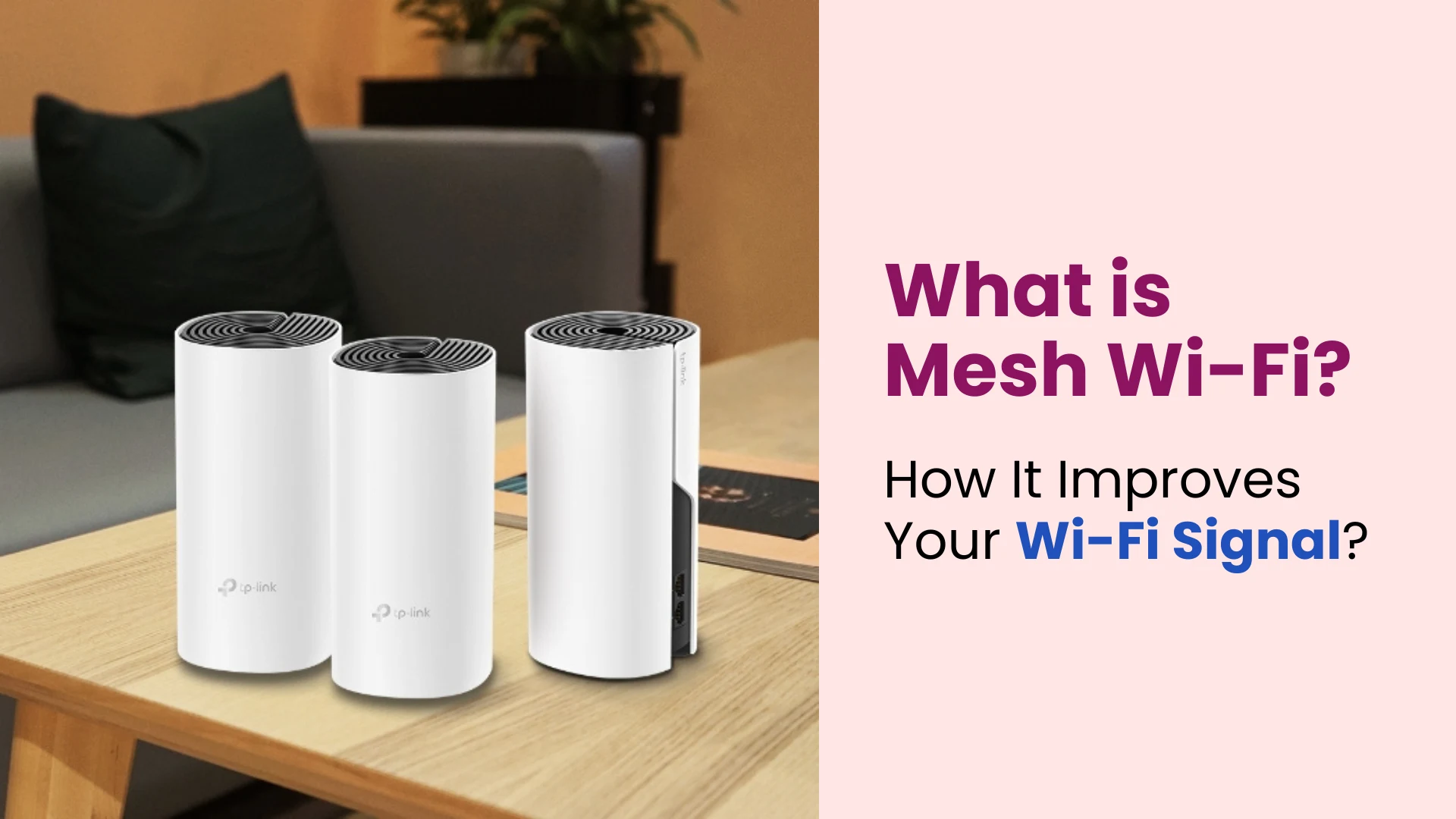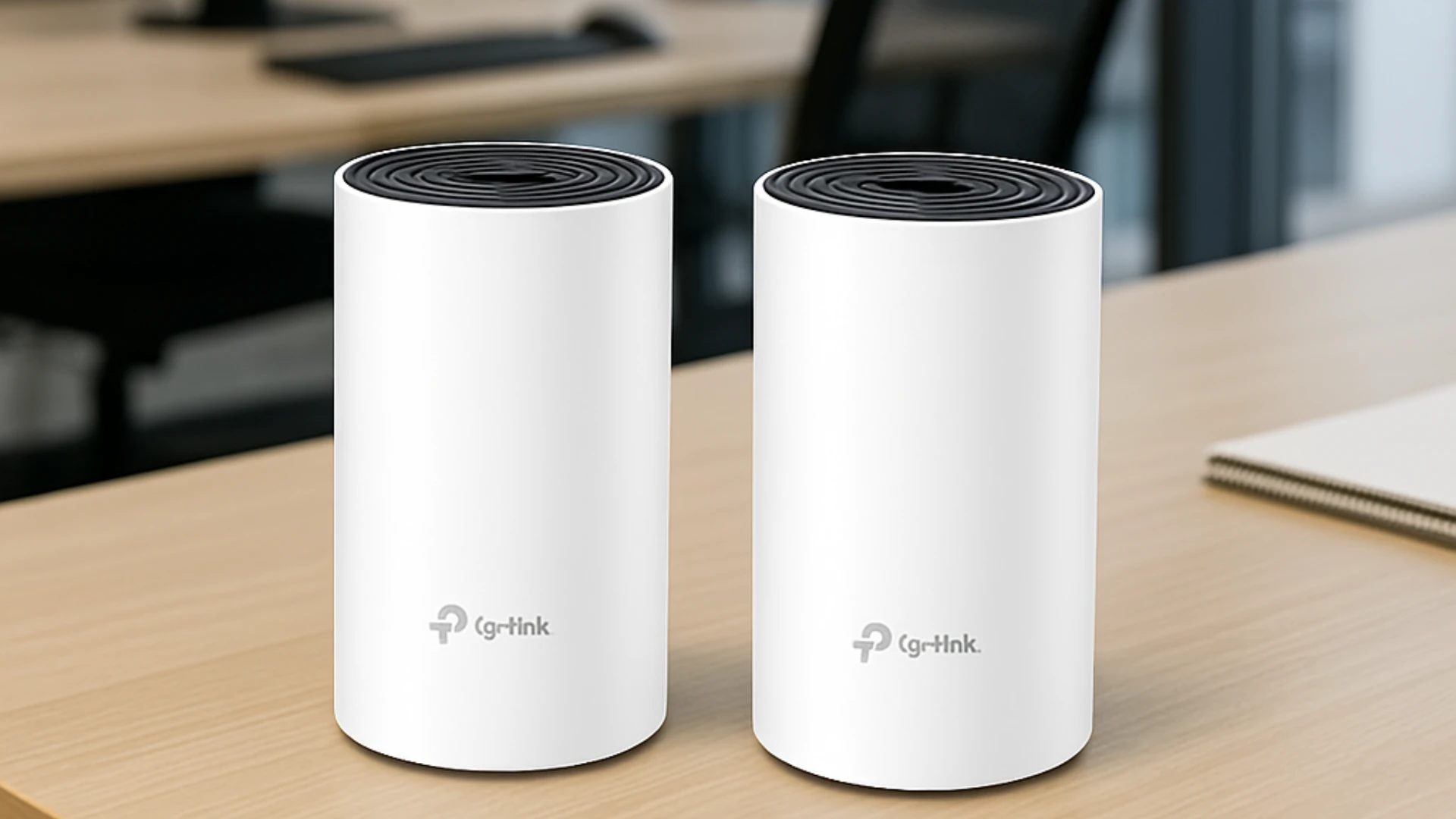
April 21, 2025
What is Mesh Wi-Fi? How It Improves Your Wi-Fi Signal?
In today’s connected world, having fast, reliable internet is no longer a luxury—it’s a necessity. Whether you're working from home, streaming your favorite series, gaming online, or attending virtual classes, consistent Wi-Fi coverage is crucial. But many homes and offices struggle with dead zones and inconsistent signals. This is where Mesh WiFi comes in.
If you're asking yourself, what is mesh WiFi, or wondering how it improves your signal strength, this guide will walk you through everything you need to know—from the basics of mesh WiFi systems to the technical details behind mesh technology in WiFi, and whether it can actually make your internet faster.
What is Mesh WiFi?
Mesh WiFi is a wireless networking solution designed to eliminate dead zones and provide seamless internet coverage throughout your home or office. Unlike traditional routers that broadcast from a single point, a mesh WiFi system uses multiple nodes (or devices) that communicate with each other to distribute the signal evenly across every corner of your space.
So, what is mesh WiFi system in simple terms? Think of it like a team of routers working together to blanket your home in strong, consistent Wi-Fi.
How Does a Mesh WiFi System Work?
A mesh WiFi system typically consists of a main router connected to your modem and a series of satellite modules (called “nodes” or “points”) placed throughout your home. These nodes communicate wirelessly with the router and each other, forming a dynamic network.
Unlike extenders or repeaters, mesh nodes don’t just repeat the signal—they intelligently route data through the most efficient path. If one node encounters interference, the system automatically reroutes traffic through another node.
This is the essence of WiFi mesh technology—a smart, self-healing network that adjusts in real-time to deliver consistent performance.
Mesh WiFi vs Traditional Routers
| Feature | Traditional Router | Mesh Wi-Fi |
| Coverage | Strong near the router, weak farther away | Strong and consistent throughout |
| Dead Zones | Common in large spaces or with thick walls | Rare due to multiple nodes |
| Scalability | Limited | Easily expandable with more nodes |
| Setup | Simpler but less powerful | Slightly complex, but user-friendly apps help |
| Performance in large homes | Poor to average | Excellent |
What is a Mesh WiFi Router and Extender?
To understand how mesh networks work, it’s important to know the roles of each device within the system. Two core components—the mesh WiFi router and the mesh WiFi extender—work hand-in-hand to create seamless coverage throughout your home or office.
What is a mesh WiFi router?
It’s the primary device in a mesh network, usually connected directly to your modem. It acts as the brain of the operation, managing how data moves across the network.
What is a Mesh Wi-Fi Extender?
Often referred to as a “node” in mesh systems, this device extends the network’s range. Unlike traditional extenders, mesh WiFi extenders communicate seamlessly with the main router and other nodes, creating a single unified network.
The main difference between a mesh WiFi router and a traditional router or extender lies in their communication. Mesh components use mesh technology to stay connected and avoid the lag or signal drop typical of extenders.
What is Mesh Technology in Wi-Fi?
Mesh technology in WiFi is a system architecture that allows nodes to communicate directly with one another rather than only with a central router. Each node acts as both a receiver and transmitter, passing data forward and backward to ensure the best possible connection path.
This “mesh” structure provides several advantages:
Self-healing: If one node goes down, others can pick up the slack.
Load balancing: Traffic is distributed efficiently, so no one node gets overwhelmed.
Adaptive routing: The network adjusts to interference or congestion in real-time.
This is what makes WiFi mesh technology powerful for larger areas or homes with unusual layouts.

Related Blog: How to Get the Best Wi-Fi Connection from Your Router?
Benefits of Mesh Wi-Fi
Mesh WiFi isn’t just a trendy tech upgrade—it solves real problems many people face with their home internet setup. Whether you’re tired of dropped connections during video calls or slow speeds in certain rooms, mesh technology offers a reliable solution. Here’s why more people are switching to mesh WiFi systems:
1. No More Dead Zones with Better Coverage
One of the most frustrating issues with traditional WiFi setups is the presence of dead zones—those areas in your home where the Wi-Fi signal is weak or completely missing. This usually happens in basements, upstairs bedrooms, garages, or behind thick concrete walls.
A mesh WiFi system solves this by placing multiple nodes (also called mesh Wi-Fi extenders) throughout your home. These nodes communicate with each other and your main router to spread the signal evenly. Instead of one central router trying to cover everything, it’s like having several mini-routers working together to give you strong internet everywhere.
2. Stay Connected Without Interruptions
With traditional WiFi extenders, your device often has to disconnect from one signal and then reconnect to another when you move through your home. This can interrupt video calls, streaming, or even cause your app to lag or reload.
Mesh WiFi uses a smarter approach. It automatically connects your device to the strongest node without dropping the connection. This is called seamless roaming. Whether you’re walking from your living room to your bedroom or heading out to the backyard, your connection remains stable and uninterrupted.
3. One Wi-Fi Name Across Your Entire Home
With a basic router and extender setup, you might see multiple WiFi names like Home_WiFi and Home_WiFi_EXT. This can be confusing, and sometimes you have to manually switch between them to get the best signal.
Mesh WiFi systems give you one unified network name (SSID) for the entire home. You’ll never have to worry about switching between networks. Your devices automatically connect to the right node, keeping things simple and efficient.
4. Control Your Network from Your Smartphone
Many mesh WiFi systems come with user-friendly smartphone apps that make it easy to manage your internet setup, even if you're not tech-savvy. These apps let you:
- See which devices are connected
- Check your internet speed
- Set parental controls and pause the internet for kids
- Troubleshoot problems with simple guidance
This makes it easier than ever to stay in control of your WiFi without needing to call in an expert.
5. Expand Coverage Whenever You Need
One of the biggest advantages of mesh WiFi is how scalable it is. That means you can start small and expand as needed. If you move to a bigger home or your internet needs grow (like adding a home office or smart home gadgets), just add more nodes to the system.
You won’t need to change your whole network—just add a new mesh WiFi extender to cover more space. This flexibility makes mesh systems ideal for growing families, home businesses, or multi-floor homes.
Does Mesh WiFi Improve Signal Strength?
Yes, Mesh WiFi improves signal strength by ensuring that each node is placed strategically to broadcast a strong signal to nearby devices. Instead of depending on a single router to send signals through walls or across large areas, mesh nodes provide “mini access points” that blanket your space.
So if you're asking, “Does mesh WiFi improve signal strength?”, the answer is a confident yes, especially in larger homes or offices with connectivity issues.
Does Mesh WiFi Make Your Internet Faster?
Technically, mesh WiFi doesn’t increase your actual internet speed (which is determined by your ISP plan), but it can make your experience feel faster.
Here’s why:
- Devices get a stronger, more stable signal.
- Intelligent routing avoids congestion and interference.
- Less packet loss and fewer disconnections.
In short, mesh ensures that you get the maximum possible speed from your plan, regardless of where you are in your home.
What is the Purpose of Using Mesh?
The main purpose of using a mesh network is to create a Wi-Fi environment that is:
1. Stable
2. Wide-reaching
3. Consistent in performance
Whether you're moving around with a smartphone, connecting smart home devices, or setting up a small business network, mesh WiFi ensures reliable coverage and speed, without the hiccups.
It’s particularly helpful in:
- Multi-story homes
- Large apartments
- Homes with thick walls or many devices
- Work-from-home setups
- Office buildings or coworking spaces
Who Should Consider Mesh WiFi?
You should seriously consider a mesh system if:
- You live in a home larger than 1,500–2,000 sq. ft.
- Your current Wi-Fi struggles to reach certain rooms.
- You use many smart devices throughout the house.
- You’re tired of switching between different extenders or networks.
- You want easy control over your network with an app.
Even for smaller homes, mesh can be a good investment for future-proofing or improving connection reliability.
Final Thoughts
So, what is mesh WiFi, and is it worth it?
Mesh WiFi is a revolutionary networking system that offers better coverage, stronger signal strength, and seamless connectivity. Thanks to mesh technology in WiFi, users no longer have to deal with dead zones, constant buffering, or the hassle of switching between networks.
While it won’t magically boost the speed from your ISP, it ensures that every corner of your space receives the best possible performance. Whether you’re a remote worker, a family with smart devices, or just someone who values uninterrupted streaming, mesh WiFi is a smart upgrade.
FAQs
1. Can I use Mesh WiFi with my current internet provider?
Yes, mesh systems work with most ISPs. You simply connect the main mesh router to your modem or gateway, and the rest of the system takes care of the coverage.
2. How many mesh nodes do I need for my home?
This depends on the size and layout of your home. A standard 2-3 bedroom house may only need 2 nodes, while larger homes or multi-story buildings might need 3 or more for full coverage.
3. Will Mesh WiFi increase my internet speed?
It won’t increase your plan’s speed from your ISP, but it will improve signal strength and stability, making your connection feel faster and more reliable throughout your space.
4. Is Mesh WiFi good for gaming and streaming?
Yes. The strong, consistent signal across nodes and low latency make mesh systems great for gaming, 4K streaming, and video calls without buffering or lag.
5. Can I add more nodes later if I move to a larger home?
Absolutely. Mesh systems are scalable, allowing you to add more nodes anytime to expand coverage without reconfiguring your entire network.
6. Is Mesh WiFi secure?
Yes, most mesh systems use WPA3 encryption and include app-based controls for managing access, setting guest networks, and applying parental controls.
7. Do all mesh systems require a smartphone app to set up and manage?
While not mandatory, most modern mesh systems offer easy setup and management through intuitive smartphone apps, making network control accessible for non-tech users.
8. How do mesh systems handle interference or node failure?
Mesh WiFi uses adaptive routing and self-healing features. If one node fails or experiences interference, the system automatically reroutes traffic through another path.
9. Is Mesh WiFi worth it for a small home or apartment?
Even in smaller spaces, mesh can be beneficial if you experience dead zones or plan to expand your network later. It ensures stable performance and easy network control.